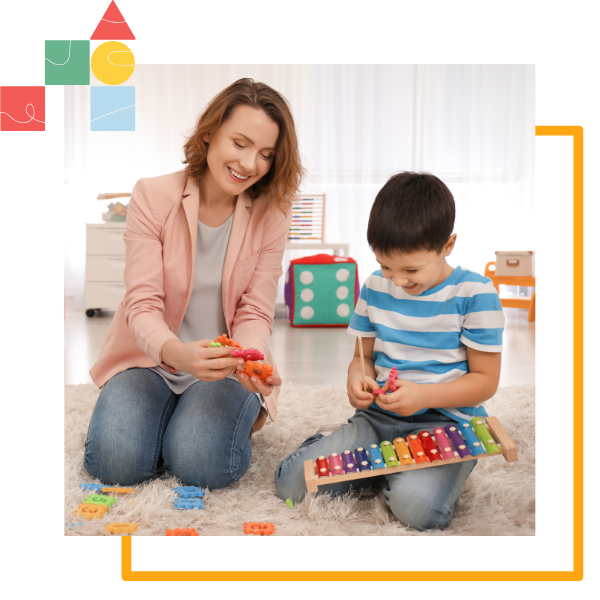Navigating social situations can be tough for anyone. But for autistic people, social interaction can be even harder due to their sensory issues. The challenges are not just with neurotypical people; connecting with others who are also on the autism spectrum can be difficult. Autism is a spectrum. This means that while autistic people have some things in common, how those traits show up and affect social situations can be very different.
Why Autistic Person Can't Get Along with Other Autistic Person?
The belief that all autistic people are the same is wrong. Like any group, autistic individuals have different personalities, choices, strengths, and challenges. While shared experiences can help create connections, believing everyone has the same thoughts without talking clearly can cause problems.
This diversity and the difficulty in seeing and responding to social cues can make it hard for individuals with autistic traits to form and keep relationships with others who are also autistic. Here are some reasons why this happens:
Reason 1: Diverse Communication Styles and Needs
Autistic people communicate in different ways, including in a different language. Some may use a lot of spoken words, while others may prefer non-verbal ways, like body language. These different communication styles can cause misinterpretations and misunderstandings. For instance, when some autistic people avoid eye contact, it might be seen as disinterest by others. However, for them, it can show comfort or focus.
Also, many autistic individuals take language very literally. This can make verbal communication harder, especially in social situations. When the conversation is not clear and direct, it can be tough for even autistic individuals to connect with each other.
Reason 2: Sensory Processing Differences
Sensory processing issues often happen in autism, particularly for those with sensory processing disorder. However, each person experiences different sensitivities. For one autistic individual, a busy social event might feel too intense. But for another, the same place could be exciting. A specific sound or texture may relax one person, while it could upset another.
These differences can lead to problems in shared spaces. Think about two autistic individuals watching a movie together. One might think the sound is too loud and want to leave, while the other could stay calm. If we do not recognize and adjust to their needs, it can cause conflict and discomfort.
Reason 3: Varied Interests and Obsessions
Autistic individuals often have strong interests and passions. However, these can vary from one person to another. These interests can be a big part of their identity and may bring them joy and motivation. Still, finding things in common can be difficult.
For example, one autistic individual might really love trains, while another is interested in astronomy. Both people might know a lot and be excited about their interests. But finding a way to connect and talk about it can take some effort and understanding from both sides. Keeping a conversation or activity going can become hard without a shared interest or connection.
Reason 4: Challenges in Social Understanding and Expectations
Autistic people often have a hard time understanding and responding to social cues. This isn’t because they don’t want to connect. It’s due to differences in how their brains process social information. This can make it hard for them to read subtle signals like facial expressions, tone of voice, or body language, which are key in social situations.
Even among autistic individuals, the challenges and ways to handle social communication situations can vary. What works for one person might not work for another. For example, someone who prefers direct communication may struggle with indirectness or sarcasm, even when talking to another autistic person. This can lead to misunderstandings.
Reason 5: The Role of Anxiety and Stress in Certain Social Situations
Social anxiety happens more often in autistic people than in neurotypical people. Even social situations that are thought to be "autism-friendly" can feel too much for them. This can lead to higher levels of anxiety and stress.
The anxiety can show in different ways, affecting how they interact with others and make new friends. One autistic person may become quiet and withdrawn when stressed. Another might talk more or get upset. For example, at a social event, if one autistic person feels very anxious, they could misread the other person's offers to connect as too much, even when those offers are well-meaning.
Strategies to Foster Positive Interactions Among Autistic Individuals
Recognizing these challenges is the first step to building good relationships with autistic individuals. Just like any healthy relationship, understanding and acceptance are important for these interactions to work well.
Creating a space where there is openness, clear communication, and respect is key. This helps autistic individuals connect better and form real bonds. It’s important to realize that communication styles, sensory needs, and comfort levels can be different. This means we need to be flexible and supportive.
Strategy 1: Creating Inclusive Environments
An inclusive place for autistic people meets their sensory needs, communication styles, and any worries they might have. This could mean providing a quiet area for them to go to if a social event feels too much or changing the lighting to help reduce sensory overload.
When planning a group gathering, it helps to ask for ideas about the location, activities, and how people want to communicate. This not only makes sure everyone feels comfortable but also shows respect for each person's needs. It helps people feel they belong. For instance, instead of thinking everyone likes hugs or handshakes, setting clear boundaries or suggesting other options is good. This can really help.
Strategy 2: Encouraging and Supporting Direct Communication
Direct communication can help clear up confusion, especially for autistic people. They may find it hard to understand body language or subtle social hints. It’s important to use "I" statements to share feelings and needs in a clear and respectful way.
For example, instead of saying, "It's too loud in here," which seems like a complaint, an autistic person can say, "I'm feeling overwhelmed by the noise; is it okay if we move to a quieter place?" This way of speaking makes it less likely for misunderstandings to happen. It also encourages honest conversation and builds empathy and understanding.
Strategy 3: Recognizing and Accommodating Sensory Needs
Creating a friendly space for autistic people is important for good social interaction. This means understanding their different ways of processing sounds and sights. For instance, picking a place with softer lighting or letting them wear sunglasses or noise-canceling headphones can help. This way, they can focus on talking instead of feeling overwhelmed by their surroundings.
It's also good to check in about their sensory needs during conversation. Asking basic questions like, "Is the lighting okay for you?" or "Do you need a break from the noise?" shows that you care and recognize that their needs matter.
Strategy 4: Facilitating Shared Interests and Activities
Finding and developing social connections through shared interests is a great way for autistic people to connect. Shared interests serve as easy conversation starters, topics to explore, and chances to work together. When someone feels excited about something, it helps with talking, even when social interaction is hard.
Think about ways to create connections through shared interests. This could include a trip to a museum exhibit about a special historical time, a board game night with strategy games, or a workshop on making model airplanes. These fun activities give a relaxed setting for interaction, allowing autistic individuals to connect over their common interests.
Strategy 5: Building Empathy and Understanding Through Education
Education helps people connect in a good way. It can be very important for autistic individuals to learn about autism from each other's personal experiences. When they share their stories, it can build empathy and understanding.
For instance, one person may talk about how they deal with social anxiety. Another might share how they handle sensory overload. These shared experiences create a base of understanding and respect, requiring hard work to deepen these connections. This can lead to stronger and more meaningful connections.
Social challenges among autistic individuals can often be addressed with personalized ABA therapy. If you're looking for ABA therapy near me for kids, local providers can offer specialized programs to help children improve communication, navigate social interactions, and build lasting relationships. Reach out today to explore how tailored ABA therapy can make a difference in your child’s social development.
Case Studies: Successful Autistic Connections
Many autistic individuals face challenges, but they also create strong and meaningful bonds with a group of friends and others like them. When we look at real-life examples, we see how understanding each other, adapting to needs, and accepting different ways of thinking can lead to wonderful friendships in the autism community.
These stories give hope and useful tips for better connections. Shared interests, online groups, and support networks often help these connections grow.
Case 1: Enhancing Communication Through Technology
Two friends with autism who like to talk in different ways found that using technology helped them connect better as close friends. One friend liked phone calls but thought texting was boring. The other friend found texting easier than speaking.
They saw this difference and chose video calls as their main way to talk. This lets them see each other’s facial expressions for better understanding. It also gave them a comfortable way to chat. By using technology to connect their communication styles, they built a strong and lasting friendship.
Case 2: A Support Group Success Story
A local group for autism support offered a safe place for autistic people to meet. An autistic adult led the group. They worked hard to make a friendly space where everyone could communicate well.
This setup made many members feel more at ease. It helped lower their anxiety. In this caring atmosphere, friendships grew strong. Sharing experiences built a sense of community. Together, people talked about common interests like video games and stamp collecting, which helped them connect and have good conversations.
Case 3: Shared Interests Leading to Friendship
Two teenagers with autism who love astronomy met at a stargazing event. At first, they felt anxious about talking to each other. However, their common interest helped them start a conversation. They talked for hours about constellations, argued about black holes, and shared what they knew.
This shared love for astronomy helped them become friends. They began going to astronomy club meetings together and took part in online discussions. They even built a simple telescope together. Their common interest made it easier for them to socialize, allowing their friendship to grow naturally.
Conclusion
In conclusion, it is important to help autistic individuals have positive interactions. This means we need to understand their different communication styles, sensory needs, and social challenges. We can do this by creating inclusive spaces, supporting direct talk, and recognizing their sensory needs. Examples show that many autistic relationships thrive through shared interests and technology, offering new perspectives on communication.
By building empathy and promoting education, we can create helpful communities for autistic people. Personalized support and specific approaches are key to building meaningful connections within the autistic community. Family members and professionals should provide a supportive environment that promotes understanding and acceptance.
Steady Strides ABA is dedicated to helping children with autism build essential social skills through personalized ABA therapy programs in Texas. By focusing on each child’s individual needs, their expert team creates strategies to improve communication and foster positive interactions, even when challenges arise.
If your child is struggling with social connections, reach out to Steady Strides ABA today to learn how ABA therapy can guide them toward healthier, more supportive relationships.
Frequently Asked Questions
Why do some autistic individuals prefer solitude?
For some autistic people, being alone is a choice. This choice comes from different reasons that can last for a long time. It includes things like how they process sensory information and how social situations can affect their mental health.
Can two autistic individuals have a successful relationship?
Absolutely! When we share openly, understand how others communicate, and work together to meet each other’s needs, autistic people can build happy and healthy relationships.
How can family members support positive interactions?
Families can help by promoting an understanding of autism. They should encourage clear communication and assist autistic individuals in building social skills. It's also important to create chances for social interaction. Finding the right kind of support for their loved one is key.
What role do professionals play in facilitating autistic relationships?
Professionals can help autistic relationships by providing tailored support. They can teach social skills and offer ways to manage anxiety. It is also important to create chances for social interaction in safe and supportive places, allowing you to express your point of view.
The Importance of Personalized Support
Personalized support is very important. This is because the needs of people with autism spectrum disorder are very different. When we offer special strategies and resources, including assistance with grocery shopping, it helps autistic individuals manage social situations better. It also allows them to form meaningful connections. Supporting their mental health is key, too.
Tailoring Approaches to Individual Needs
There isn’t a single way that works for everyone when it comes to social interaction for people with some form of autism. It’s important to adjust strategies to meet individual needs, communication styles, and comfort levels. This helps create positive and successful connections.
The Significance of Community and Social Networks
Community and social networks designed for autistic adults help neurodivergent people feel they belong. They provide chances to make peer relationships and offer tools to handle social situations. These networks bring important support and connection.
Sources:
https://www.ambitiousaboutautism.org.uk/about-us/media-centre/blog/10-reasons-people-autism-struggle-friendships
https://www.altogetherautism.org.nz/friendship-may-look-different-for-autistic-people/
https://www.helpguide.org/mental-health/autism/adult-autism-and-relationships
https://journals.sagepub.com/doi/10.1177/1362361320908976
https://www.autism.org.uk/advice-and-guidance/topics/family-life-and-relationships/making-friends/autistic-adults
https://edward-john.medium.com/why-autistic-people-dont-necessarily-get-on-well-with-each-other-7f3dfc778931
https://theconversation.com/how-autistic-and-non-autistic-people-can-understand-each-other-better-234320













